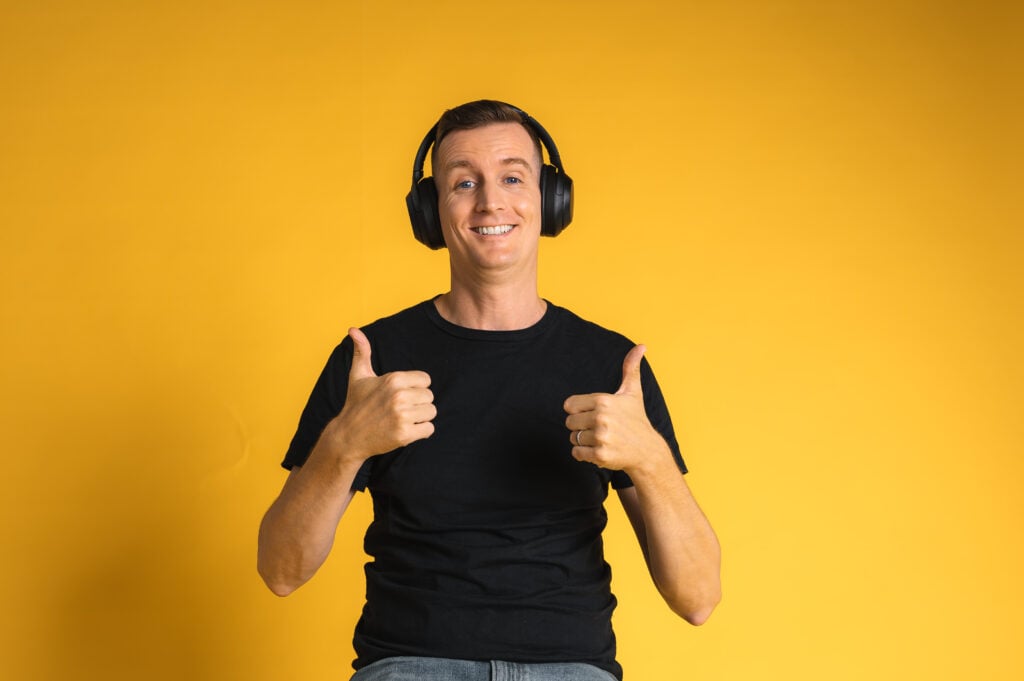If you’re still relying on traditional podcast promotion – posting an episode and hoping listeners find it – you’re already falling behind.
My name is Niall Mackay, The Podcast Guy. I am the founder of Seven Million Bikes Podcasts and host of this show – Smarter Podcasting. My guests and I share valuable insights and strategies for building and promoting podcasts.
Although I have been doing podcasts for years, I sometimes still struggle with promoting my shows. That’s why in this episode, I talked to Marcus Logan, one of New Zealand’s top podcast marketers.
Let’s break down our 5 secrets of the power of short-form content and How To Promote A Podcast On Social Media.
Table of Contents
My Podcasting Journey & The New Zealand Podcast Landscape
I started my podcasting journey as a way to share stories, connect with interesting people, and build a community around shared experiences. What began as a fun experiment quickly turned into a passion, leading me to create multiple podcasts and help others launch their own. Along the way, I discovered the challenges and opportunities that come with podcasting, especially in a country like New Zealand, where the industry is still growing.
I left New Zealand for what was supposed to be a year, but nine years later, I’m still in Vietnam. When I left, I couldn’t even think of any New Zealand podcasts I listened to. Back then, I was hooked on Serial—the Adnan Syed case—which was part of the big podcast boom in 2014. But apart from that, nothing really stood out in the New Zealand podcasting scene.
Podcasting Scene in New Zealand
I asked my guest Marcus about the podcast landscape in New Zealand. Marcus explained that in New Zealand, many traditional media companies are now launching podcast brands. TV and radio personalities are transitioning into podcasting, partly because the industry has become more profitable, but also because traditional media in New Zealand is struggling.
Regional newspapers have shut down, major news channels have disappeared, and hundreds of media professionals are looking for new opportunities. With podcasting growing and advertisers coming in, it’s becoming a real alternative for those who previously worked in mainstream media.
What Defines a Podcast?
But then I asked Marcus a question I had never really thought about before: What actually defines a podcast?
He shared an interesting perspective. Some content is labeled as a podcast but is really just a repurposed video or TV show. A good example is a sports TV show from the 90s that was relaunched as a podcast, even though it was primarily made for YouTube. The audio was then distributed on Spotify and Apple Podcasts.
So is that really a podcast? Marcus pointed out that with streaming and social media, many creators now take clips from their content and upload them as podcasts, even if they weren’t originally recorded with podcasting in mind.
That got me thinking. When I first started, I was a purist—podcasts had to be audio-only, delivered through an RSS feed. Now, my perspective has completely changed. I do video podcasts, and I tell my clients to do videos as well. In fact, I still get surprised when a client says they want to start a podcast, and I forget that they mean video, not just audio. Video adds so much complexity to the process—more editing and more production time. Honestly, I probably need to start charging more for it!
The Shift In Consumer Trend
The shift toward video is being driven by younger audiences. While many still listen to traditional audio podcasts, others only engage with short clips on social media platforms like TikTok, Instagram, and YouTube Shorts.
For some, a podcast isn’t about where or how they consume it; it’s simply any content featuring someone speaking into a microphone. They might never watch a full episode, but they recognize the format as a podcast because they see these clips everywhere.
This has led to an interesting trend—fake podcast clips. Some creators now produce content that looks like a podcast, even though it isn’t part of a larger show. They use this format purely for social media engagement, leveraging the credibility and appeal of podcast-style discussions to attract viewers.
Secret 1: How To Create The Best Clips
As we discussed, the young generation is leading the new trend of podcast consumption – short clips. As podcasters, we need to adapt and come up with new strategies. Creating clips that perform well can feel like a mystery. Some clips go viral, while others barely get any engagement. So what’s the secret?
Context-Free, Engaging Content
One of the biggest mistakes in podcast marketing is assuming the audience already knows or cares about the people or topics in the clip.
A successful clip should be universally relatable, capturing attention instantly. If someone scrolling through social media stops to watch, they should be able to engage with it without needing background knowledge.

The first three to four seconds are crucial. If you don’t grab attention immediately, users will skip past it. Social media algorithms reward videos that hold attention, meaning that longer watch times lead to greater reach. This is why a strong hook at the beginning of a clip is essential.
How To Find The Perfect Clips
When selecting moments from a podcast episode, look for:
- Attention-grabbing statements – Something that naturally sparks curiosity.
- Story beginnings – A compelling setup that makes viewers want to hear the rest.
- Strong opinions or controversial takes – Statements that provoke thought or debate.
- Funny or engaging moments – Clips that make people laugh or feel something powerful.
Even if these moments don’t occur naturally at the start of a conversation, they can be edited to create a more engaging opening. The key is to grab attention instantly and keep viewers watching.

Pre-Planning for Social Media Success
While not always necessary, pre-planning can help ensure that podcast episodes contain shareable moments. Some podcast hosts do extensive pre-production research to identify topics likely to engage a broad audience. Others may even plan specific questions designed to create viral moments.
For those producing clips, it’s helpful to reverse-engineer engaging content. If a host asks a controversial question or sets up a bold opinion, those moments can be identified and repurposed as strong hooks for social media.
Different Content for Different Platforms?
A common question for podcasters is whether they should post the same content across different platforms or repurpose it.
Marcus explained that while there are slight differences in formatting, the core content remains the same. The key is to maximize the reach of a single piece of content by distributing it across multiple channels.
Short-form video is currently the dominant format across social media. Marcus and his team focus on pushing their content to platforms that prioritize short videos, such as:
- Facebook Reels
- Instagram Reels
- TikTok
- YouTube Shorts
- X (formerly Twitter), though it has less traction in some regions
While content may perform differently on each platform, a well-performing video on one platform is likely to succeed on others.
Marcus also highlights that modern social media algorithms no longer guarantee that all of your followers will see your content. Instead, platforms prioritize discoverability, meaning your content is shown to users based on their interests rather than strictly to your existing audience.
Related Post: 5 Steps To Promote Podcasts on Social Media
Secret 2: Short-Form Content in Discoverability
A major difference between traditional podcast distribution and social media lies in audience reach. With an audio podcast, most listeners come from your existing followers—people subscribed via your RSS feed. However, short-form videos have a unique advantage: they can reach a global audience instantly.
Marcus describes each short video as a “lottery ticket” for virality. Unlike traditional social media, where reach was largely determined by follower count, today’s algorithms reward engaging, high-quality content. Platforms like TikTok revolutionized this model, leading others to follow suit. The focus is no longer just on follower numbers, but on content quality and engagement. This shift makes it easier than ever to gain organic reach without relying on paid advertising.

Secret 3: Case Study for Viral On Social – A Lottery Ticket
Marcus described social media as a kind of “lottery ticket” for exposure, and he was absolutely right. I had already seen this firsthand.
A few months ago, when Vietnam won the AFF Cup against Thailand, I filmed the celebrations with my new Osmo Pocket 3 camera and quickly edited and posted the footage. I didn’t expect much from it—I even joked to my wife that maybe 70 people would see it. Instead, the video blew up, getting over 150,000 views and even earning monetization.
This experience reinforced something important: viral moments can’t always be predicted, but creating timely, engaging content increases the chances of reaching a wide audience. The algorithms favor content that keeps people engaged, so if you put out quality videos at the right time, they will get pushed to more viewers.
Watch it here
Why Did This Video Go Viral?
At first, I didn’t fully understand why this particular video had blown up, but after looking at the data and reflecting on the factors at play, I realized a few key reasons:
- Timeliness & Relevance
- The video captured a major national moment—Vietnam winning the AFF Cup.
- People were already searching for and engaging with content related to the match.
- Social media platforms prioritize trending topics, so this content naturally aligns with what people want to see.
- Emotional Connection
- The energy in the streets was electric, and the video conveyed that excitement.
- People felt a sense of pride and nostalgia, which made them want to comment, like, and share.
- Engaging emotions—whether excitement, humor, or surprise—is a proven way to boost virality.
- High-Quality Footage
- Filming with the Osmo Pocket 3 meant the video had smooth, professional-looking footage.
- Clear visuals and good audio made it easy for viewers to enjoy and engage with the content.
- Quality matters—people are more likely to watch and share something that looks and sounds great.
Going viral wasn’t something I planned, but it was a turning point in how I approached content creation.
Want to start your video? How To Record A Video Podcast – 4 Steps For Success
Secret 4: Converting Short-Form Viewers into Long-Form Listeners
Now you may succeed in catching the attention by creating short clips, but how can these viewers become your podcast audience?
The conversion success depends on the quality and appeal of the short-form content. If a clip is engaging enough, it will naturally encourage viewers to seek out the full episode. However, because this process isn’t always automatic, podcasters need to take additional steps to guide their audience:
- Clear Calls to Action: Include text or voice prompts at the end of a clip directing viewers to the full episode.
- Text Overlays: In the last few seconds of a clip, remove subtitles and display a simple text prompt like “Watch the full episode.”
- Captions and Descriptions: Use video descriptions to include links to the full episode and emphasize the value of watching the whole conversation.
- Stories & Links: Utilize Instagram Stories, Facebook Stories, and TikTok Stories to share links and direct traffic.
While not every short-form viewer will convert immediately, strong engagement on social media helps build long-term brand recognition. As engagement grows, the opportunity to convert casual viewers into dedicated listeners increases over time.
Secret 5: Social Media in Podcast Growth and Monetization
I’ve always followed the data, and over the past few months, I saw some of the biggest growth in my podcast’s history. December and January were our two highest months ever—five years after starting A Vietnam Podcast. I started looking at what had changed, and it became clear that several factors contributed to this success.
- Website
One of the biggest shifts was creating a website. For years, we didn’t have one, but once we did, we had a dedicated place to direct listeners. Having a website for your podcast is one of the best ways to grow a podcast, and the numbers back it up.
- Social Media Content
On top of that, we started producing video content seriously for the first time and put more effort into short-form social media clips. Another major change was increasing the number of episodes from one per week to two. I assumed all of these factors played a role, but it was difficult to pinpoint exactly which one made the biggest impact.
Monetization Beyond Podcast Sponsorships
Social media wasn’t just helping podcasters get discovered—it was also opening new revenue opportunities.
- Traditionally: podcast monetization meant landing sponsors who paid to advertise within episodes.
- Now: podcasters could make money through brand deals and sponsored content outside of the podcast itself.
Marcus mentioned that many full-time podcasters he worked with were securing sponsorships based on their social media presence, not just their podcast downloads. Brands wanted access to their audience across platforms, and that meant podcasters with strong social media engagement had an additional way to generate income.
Conclusion – How to promote a podcast on social media
Looking back at my own journey, the biggest lesson I’ve learned is this: podcasting is more than just talking into a mic. It’s about storytelling, audience connection, and leveraging every tool available to grow and sustain a loyal listenership. If you’re willing to evolve with the industry, the opportunities are endless.
So start recording videos for your podcast and leverage social media for a bigger impact.
If you need any help with your show, just contact me!


